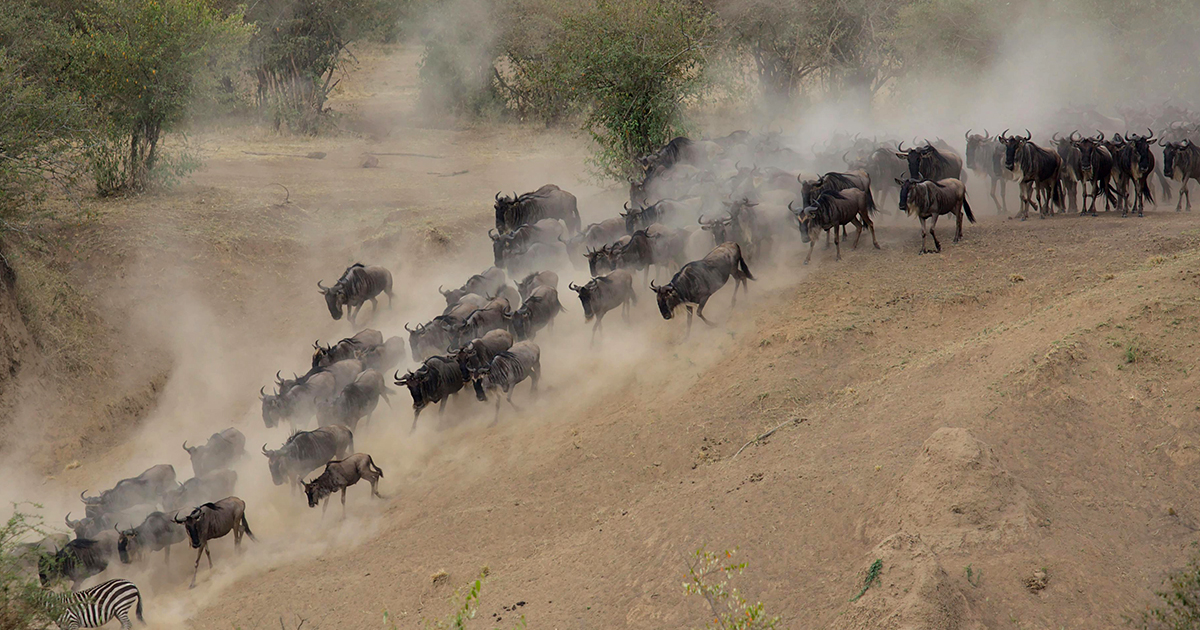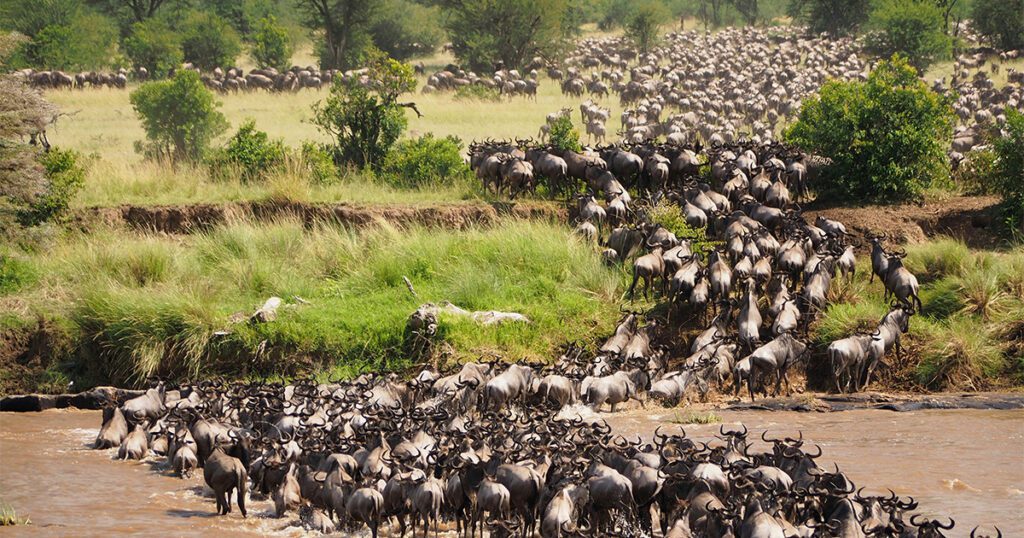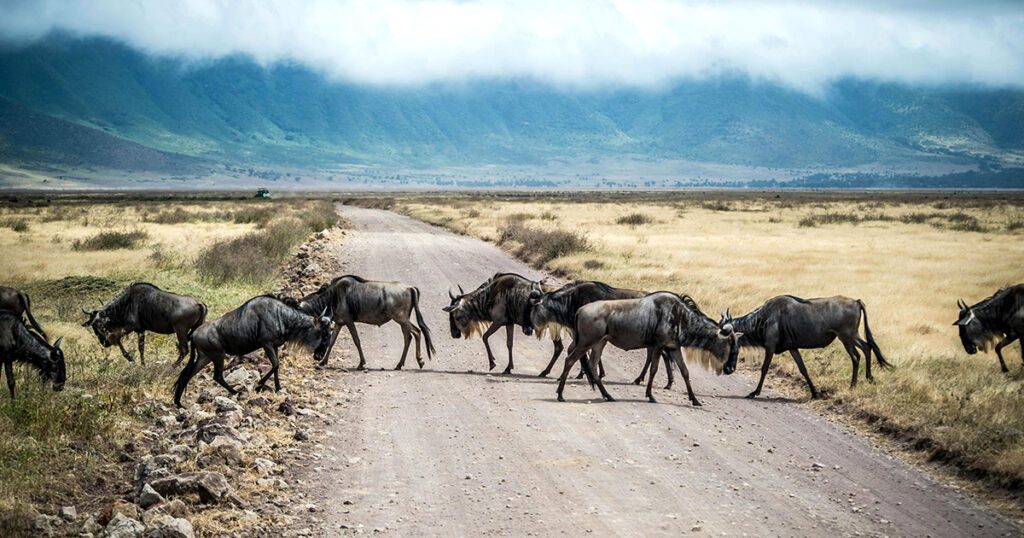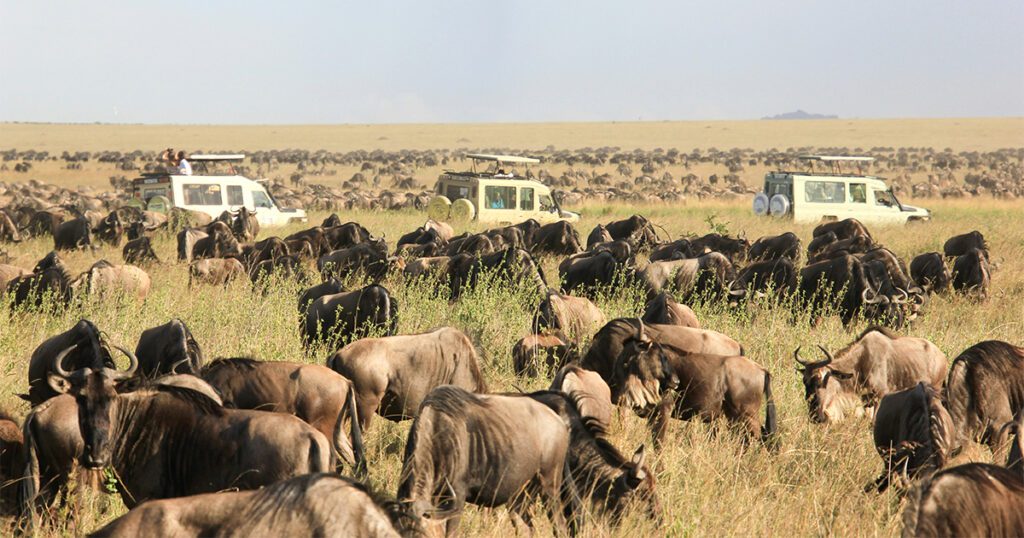
Chasing the Beasts: Your Roadmap to Witnessing the Great Migration 2024
- byscarfacepride
- - July 19, 2024
Home » Blog » Chasing the Beasts: Your Roadmap to Witnessing the Great Migration 2024
Millions of wildebeests and other animals thundering across the plains, crossing crocodile-infested rivers, and creating a spectacle unrivaled in the wildlife world. Who would want to miss such a stunning spectacle? Definitely not you, we bet!
So, here we are, ready to tell you everything about the Great Migration in East Africa. From the best places to witness the Great Migration to the best time to plan your trip—we are about to tell you everything about this dramatic phenomenon.
Best Places to Witness the Great Migration
The beauty of the Great Migration is, it is not a standalone annual event when throngs of wildebeests cross the Mara River to enter Maasai Mara.
In reality, the migration is an unceasing, year-round movement of over 1.5 wildebeests and over half a million zebras, gazelles, topis, and other animals as they search for greener pastures and water across the Serengeti and Maasai Mara plains.
Since the herds are constantly moving, the best places for witnessing them depend on where they are at a particular time of the year. The movement depends heavily on rain patterns and erratic animal behaviors, so it’s impossible to predict it accurately.
Nevertheless, we will take you through the general year-round migratory patterns so you can better decide when to plan your safari. There are plenty of comfortable lodges and camps spread across the Serengeti and Maasai Mara, so you can rest assured that you will get the best accommodations all year round!
January to March: The Calving Season

Where to Find Them:
Southcentral to Southern Serengeti (Tanzania)
What to expect?
While wildebeests and other animals don’t follow the calendar, they begin giving birth around the beginning of the year after they return from their northbound journey.
By late November to early January, almost all the wildebeests are back in the Serengeti regions of Tanzania. You can find them spread all the way from Moru Kopjes in the south-central Serengeti to the Ndutu plains and Ngorongoro highlands further south.
During this time, the plains are rife with short grass. The fresh, green grass is rife with nutrients like protein and calcium, which are ideal for raising young calves to be born in the following weeks.
Why should you be here?
If you plan your East African safari in late January, February, or early March, you will be a witness to one of the largest mass-calving phenomena in the world.
Within 2-3 weeks, the southern Serengeti plains are full of over 500,000 calves that are born before the start of the long rainy season in March. With a mix of vigilance and luck, you may even watch a wildebeest mother giving birth to a calf! The little wildebeests start walking just minutes after birth.
Besides, there is something else you can witness around this time: predators on the hunt! Lions, leopards, cheetahs, hyenas, and other predators spring to catch and prey on the wobbly little calves. You will get to watch the hunt live with less crowd, as this is the mid-season with fewer tourists.
Best places to stay in:
1. Lake Masek Tented Lodge (Ndutu, Tanzania)
Spacious tents on the banks of Lake Masek with Wi-Fi, a swimming pool, round-the-clock electricity, and private terraces.
2. Olakira Camp (Ndutu, Tanzania)
Cozy tents with wooden decking for safety, mesh-covered design for stargazing, and en-suite bathrooms with hot showers.
3. Nyikani Ndutu Migration Camp (Ndutu, Tanzania)
Elegant tents are rife with wash basins, running water, en-suite bathrooms, and other essential amenities.
4. andBeyond Ngorongoro Crater Lodge (Ngorongoro Crater, Tanzania)
Handcrafted mud-and-thatched suites nestled in the Ngorongoro Crater offer stunning views and personalized adventure activities.
April to June: Migration begins with Mating

Where to Find Them:
Central and Western Serengeti (Tanzania)
What to expect?
The period from March to May is the season of heavy rains in East Africa. The rains, called Masika in Swahili, keep the plains rife with green grass and enough water. However, as the rains start slipping away by late April or May, wildebeests start moving towards more food and water.
Hundreds of thousands of wildebeests start going west across the Dutwa and Ndoha plains before arriving on the southern banks of the Mbalageti River. Many wildebeests take an alternate route as they move directly northwards through central Serengeti, across the Seronera plains and the Lobo Valley.
Depending on their course, the wildebeests must cross the crocodile-filled Mbalageti River and the Grumeti River as they travel towards northern Serengeti and Maasai Mara beyond.
Why should you be here?
Mating is the highlight of this part of the Great Migration. The rut begins around late May and early June as the males compete aggressively for female attention.
If you are in Tanzania during this time, you will get a chance to witness fierce head-to-head combats between male wildebeests (the bulls) as they prove their physical worth to the females (the cows). These deadly fights are a treat to watch and can be one of the highlights of your safari.
Migration continues with mating as the wildebeests move westwards and northwards. While you cannot watch the iconic Mara River crossing during this time, you can witness a mini-version by watching throngs of wildebeests crossing the Mbalageti and Grumeti rivers.
Best places to stay in:
1. Ole Serai Luxury Camp (Central Seronera, Tanzania):
Luxury 5-star camps with en-suite flushing toilets, pressurized running showers, and 24-hour uninterrupted power supply.
2. Dunia Camp (Moru Kopjes, Tanzania):
Africa’s only all-women-operated camp equipped with Wi-Fi, en-suite bathrooms, hot showers, complimentary laundry services, and more.
3. Pumzika Luxury Camp (Nyabogati, Tanzania):
Comfortable accommodations with all lavish amenities and several common areas like dining tents, lounge, and campfire.
4. Kubu Kubu Tented Lodge (Oljaro Road, Tanzania):
Luxurious tented rooms with basic amenities like hot shower, Wi-Fi, solar power, and more, along with a gym, so you don’t miss your fitness routine.
July to October: The Mara River Crossings

Where to Find Them:
Northern Serengeti (Tanzania) and Maasai Mara (Kenya)
What to expect?
Millions of wildebeests, zebras, gazelles, and other animals continue their journey northward across the northern Serengeti until they reach the southern banks of the Mara River.
Depending on the year’s rain patterns, the first herds usually arrive between early July and late August. However, arriving on the banks and crossing the Great River are two different things.
Crossing the Mara is the most daunting task of the migration. The wildebeests may wait for days in the bank without budging, huddling in large numbers until the chaos finally breaks loose. While many wildebeests are devoured by crocodiles lurking silently below the water, most manage to cross the river alive.
The river crossing happens in multiple spots across the river. By September or early October, most wildebeests have crossed the river and entered Maasai Mara, grazing the green plains and gradually moving eastwards.
Why should you be here?
If witnessing the iconic Mara Crossings is at or near the top of your safari bucket list, July-August is the best time to plan your visit. But be prepared for crowds because this is the peak safari season. Moreover, make sure to book your trip at least a year in advance!
Once you are here around this time, you’ll stand a chance to witness one of the most appealing visual spectacles of the animal world. However, there is no guarantee because even if you see wildebeests on one side of the river, they may or may not cross it during your stay.
That said, if the wildebeests arrive on the other side of the Mara while you’re there, you can go on safari game drives to view lions, cheetahs, and other predators getting into gear to feast on the new guests.
Best places to stay in:
1. Singita Mara River Tented Camp (Lamai, Tanzania):
Eye-catching traditional Maasai-inspired camp designs mixed with modern amenities and great experiences, including a swimming pool, complimentary Wi-Fi, and more.
2. Sayari Camp (Northern Serengeti, Tanzania):
The spacious camps boast mahogany floors, a spa, a microbrewery, and a private deck, along with a swimming pool, Wi-Fi, and other essentials.
3. Sand River Camp (Maasai Mara, Kenya):
A 1920s-style set of tented camps reminiscent of the golden era of African culture, complete with all modern facilities and beautiful interior designs.
4. Entim Mara Camp (Maasai Mara, Kenya):
One of the most luxurious camps with luxury rooms on wooden decks, complemented by a private lounge and veranda!
November to December: There and Back Again

Where to Find Them:
Northern to Central Serengeti
What to expect?
The short rain season—called vuli in Swahili—begins in East Africa by late October or early November. It brings intermittent downpours and reminds the wildebeests to return to their southern homes in Serengeti.
The herds have to cross the Mara again, creating a similar spectacle as before. They travel south across the southern Maasai Mara to the Lobo and Loliondo regions in the northern Serengeti before reaching the Namiri plains in the east.
From there, they continue their journey till the end of the year, spreading across the central and southern regions of the Serengeti. By late December to early January, most wildebeests are back in the southern Serengeti, and the cycle continues.
Why should you be here?
Unlike the long rain season, the short rain season is much more favorable to tourists as the rains are milder and more discontinuous. So, if you are here during this time, you can enjoy the pleasant weather without experiencing any trouble.
While you follow the migration route, you can witness many other great things along the way. The Namiri Plains are popular for offering the best cheetah-viewing opportunities across the Serengeti, while the Ngorongoro Crater is a UNESCO World Heritage site with stunning scenic beauty and a unique ecosystem.
Since this is not the peak season, you will enjoy your safari without the bustle of tourists. Witness the Big Five, wildebeests, zebra, gazelles, and many other animals—all in the backdrop of lush green plains.
Best places to stay in:
1. Melia Ngorongoro Lodge (Ngorongoro, Tanzania):
Lavishly designed tents with spacious interiors located in the Ngorongoro Crater, with a range of suites with different complimentary amenities.
2. Nimali Ndutu Camp (Makoma Hill, Tanzania):
Tented suites with interior designs inspired by skin and bone colors, spa treatments, bush lunches, and sundowners as unique amenities.
3. Serengeti Woodlands Camp (Naabi Hills, Tanzania):
Spacious tents overlooking the Naabi Hills offering a mix of safety, comfort, great food, and a range of complimentary experiences to elevate your safari.
4. Ang’ata Migration Camp (Ndutu, Tanzania):
Nestled on the Rift Valley, near Lake Ndutu, with en-suite bathrooms, a common lounge, and a dining tent—all amid the backdrop of sweeping Ndutu Plains.
The Wildebeests are Calling!

Kenya and Tanzania are rife with great places to witness the Migration. But if you have specific safari goals, it’s best to plan accordingly. While July-September is the ideal time for witnessing the Mara crossings, November-December and May-June offer great experiences with less crowd.
There is no dearth of comfortable lodges and camps, so you can rest assured that you will get the best accommodations no matter when you visit. Whenever you plan your safari, Scarface Pride will ensure you get the best convenience and places to stay. So, plan your safari with us now!
Frequently Asked Questions (FAQs)
Where is the best place to see the Great Migration?
Since the Great Migration is an unceasing phenomenon, the ideal place depends on when you plan your safari in East Africa. That said, if you are keen to witness the iconic Mara River crossings, northern Serengeti and Maasai Mara are the best places to see the migration.
How do you witness the Great Migration?
You can witness the migration by visiting the Maasai Mara and Serengeti regions across Kenya and Tanzania.
Plan your safari according to your migration bucket list. Book well in advance to get the best camps during peak season (July-October). Or, visit in January-March or November-December to escape too much crowd and expense.
Which is better: Serengeti or Maasai Mara?
Both Serengeti and Maasai Mara offer unique and incredible safari experiences and opportunities to witness the Great Migration. While Maasai Mara is particularly hyped because of the Mara crossings, the wildebeests spend most of their time in Serengeti. We suggest you include both places in your itinerary to make the most of your safari!
Is seeing the Great Migration worth it?
The Great Migration is one of the craziest phenomena in the wildlife world, so seeing it is an experience of a lifetime and definitely worth it. However, it is in no way an indispensable part of a safari. An East African safari has much more to offer, and you should go there for everything else there is to experience other than the migration.
